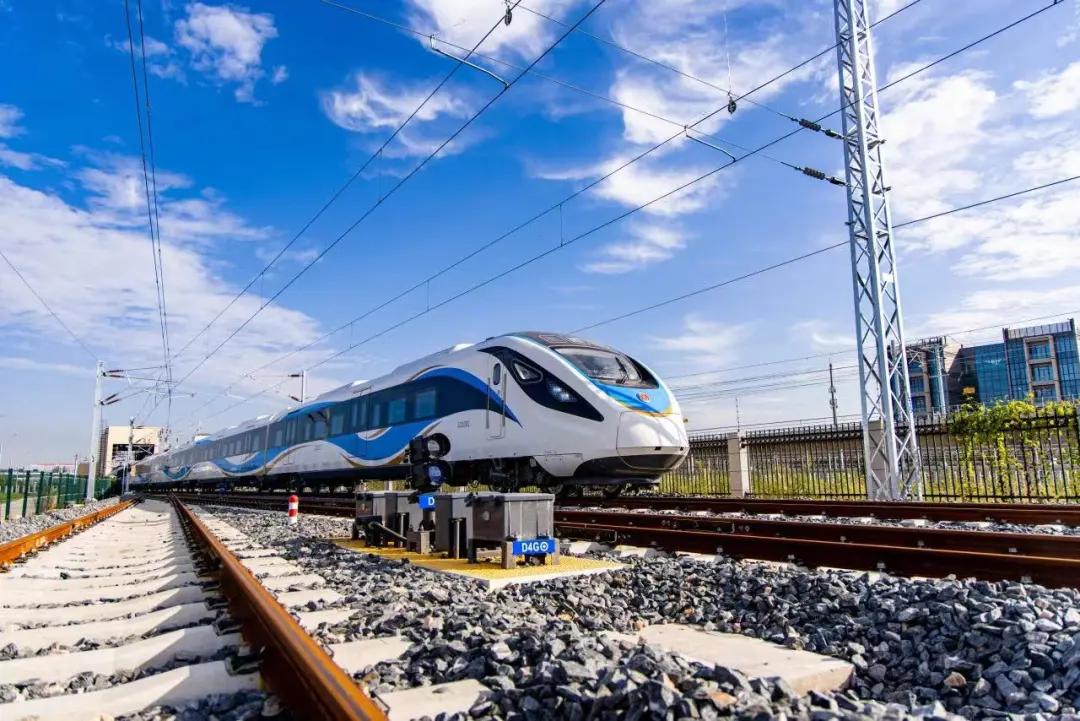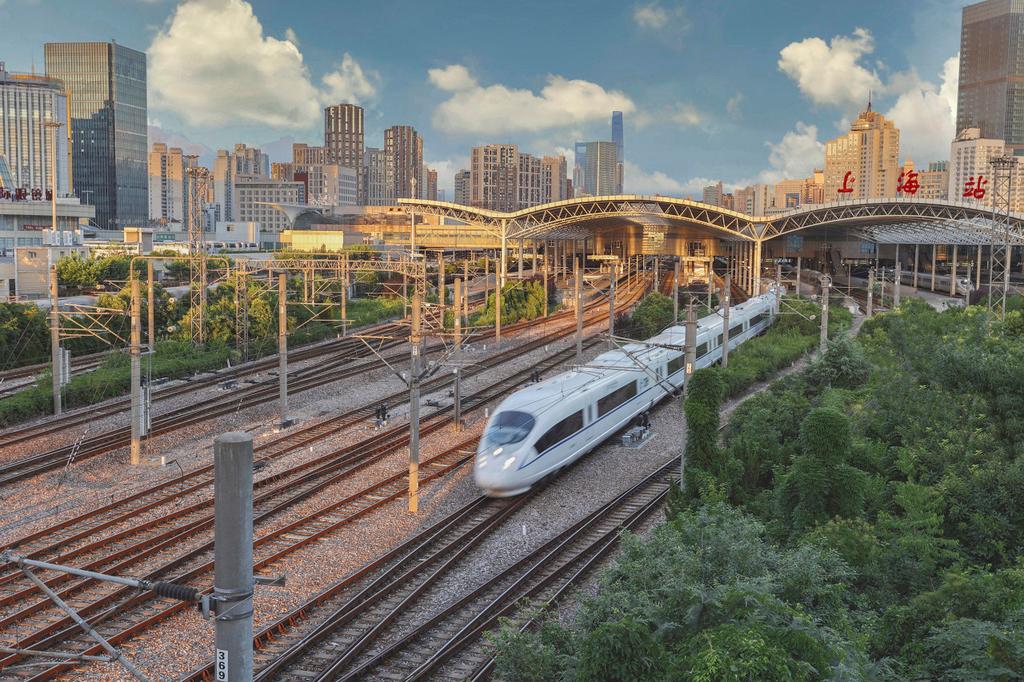Shanghai's top 10 transportation events in 2024 unveiled
The Shanghai Municipal Commission of Transport has unveiled the top 10 transportation events in Shanghai in 2024. Take a look at the list below. Which one most resonates with you?
1. Shanghai airport rail link

Shanghai opened its first airport rail link on Dec 27, reducing transit time between Hongqiao International Airport and Pudong International Airport to just 40 minutes.
The 68.6-kilometer line runs at a top speed of 160 km per hour. It is one of 11 pilot suburban rail lines in the country and Shanghai's first suburban rail line to be independently funded, built and operated.
The rail link will streamline travel within the city and support the integrated development of the Yangtze River Delta region.
→ Shanghai airport rail link cuts transit time to 40 mins
→ How to take the Airport Link Line
→ Airport rail link offers digital services, discounts
2. Shanghai-Suzhou-Huzhou high-speed railway

The Shanghai-Suzhou-Huzhou high-speed railway began operating on Dec 26, linking three major cities in the Yangtze River Delta region: Shanghai, Suzhou in Jiangsu province and Huzhou in Zhejiang province.
The new 164-kilometer line connects eight stations, with a designed speed of 350 kilometers per hour, reducing travel time between Shanghai and Huzhou from nearly two hours to just 55 minutes.
This high-speed rail line is an important addition to the "Yangtze River Delta on Rails" initiative, aimed at bolstering regional integration and alleviating transport pressure on the Shanghai-Nanjing and Shanghai-Hangzhou rail corridors.
→ New Shanghai-Suzhou-Huzhou high-speed rail line to open soon
3. Shanghai South Station and Shanghai Songjiang Station

After nearly six months of upgrades, Shanghai South Railway Station finally met the required standards for static inspection on Dec 20.
The station marked the start of its high-speed rail era with the departure of train G1305 on Jan 5.
→ Shanghai South Railway Station renovation plans on track

Shanghai Songjiang Railway Station commenced operations on Dec 26, 2024.
It is a major hub of the Shanghai-Suzhou-Huzhou High-speed Railway and the third-largest railway station in Shanghai, following Shanghai Hongqiao Railway Station and Shanghai East Railway Station.
→ Shanghai Songjiang Railway Station nears completion for opening
4. The eastern section of Beiheng Passage

The main line of the eastern section of Beiheng Passage, a new east-west thoroughfare in Shanghai, began trial operations on Aug 2.
The passage stretches 19.1 kilometers, passing through six districts — Changning, Putuo, Jing'an, Huangpu, Hongkou and Yangpu. It will reduce travel time across these six districts to just 40 minutes.
5. Shanghai Port

Shanghai Port became the first in the world on Dec 22 to cross the 50-million-TEU mark in annual container throughput.
From January to December 2024, it saw 51.506 million TEUs in container throughput, an increase of 4.8 percent year-on-year, ranking first globally for the 15th year in a row.
→ Shanghai Port sees annual container throughput exceed 50m TEUs
6. Yindu Road cross-river tunnel

The Yindu Road cross-river tunnel opened to traffic on Dec 27. It starts from the intersection of Jingdong Road and Yindu Road in Xuhui district and stretches to the intersection of Pujin Road and Luheng Road in Minhang district, with a total length of about 3.8 kilometers.
The road was designed as a double-deck tunnel, featuring two levels with four lanes each for two-way traffic.
It will enhance the city's main road network and promote the integrated development of both sides of the Huangpu River.
7. Rural roads, buses for the elderly and more parking lots

In 2024, Shanghai upgraded 301 kilometers of rural roads, covering nine administrative districts and 247 roads – surpassing its initial target.
To enhance the travel experience for the elderly, the city launched 400 accessible low-floor new energy buses and introduced 60 senior citizen-friendly bus routes.
In addition, 168 bus stations were renovated to be more age-friendly, with improvements such as platform height adjustments and added warning signs.
To resolve parking difficulties in specific areas and times, Shanghai began building 5,877 new public parking spaces and added 2,608 parking lots for staggered shared parking. Additionally, 22 model smart public parking lot and garage projects were completed.
8. Demonstration zone for cooperative management of low-altitude airspace

The Shanghai Low-Altitude Cooperative Management Demonstration Zone was unveiled at the East China UAV Base in Jinshan district on March 29, marking the start of Shanghai's efforts to demonstrate the cooperative management of low-altitude airspace.
The city has unveiled its action plan for the development of the low-altitude economy (2024-2027), planning to offer at least 400 low-altitude flight routes by the end of 2027.
9. Interoperable travel QR codes between Shanghai, Taizhou

The QR codes for public transportation were mutually recognized between Shanghai and Taizhou, Zhejiang province, in 2024. This initiative brings the Yangtze River Delta region a step closer to integrating its transport network.
As a result, residents of both cities can now access public transportation seamlessly across the two cities, without the need to download the other city's app or apply for a separate code. They can simply use their locally issued code to travel throughout either city.
Shanghai has also achieved interoperability of transportation codes with both Ningbo and Jiaxing.
10. The first green, low-carbon highway service area

The first green, low-carbon highway service area in Shanghai, the Zhuqiao Service Area, was completed and put into operation in 2024.
The service area features solar panels installed on the roofs of both the comprehensive building and the drivers' rest area, with a total installed capacity of 243 kilowatts per hour.
The solar panel system covers 1,170 square meters, accounting for 85 percent of the roof’s total area. It is expected to generate 200,000 kWh of electricity annually, or an average of 500 kWh per day.
Source: Shanghai Municipal Commission of Transport
